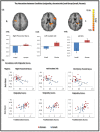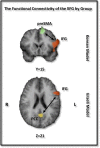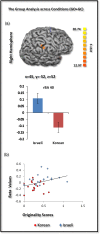The neural underpinnings of cross-cultural differences in creativity
- PMID: 29974553
- PMCID: PMC6866326
- DOI: 10.1002/hbm.24288
The neural underpinnings of cross-cultural differences in creativity
Abstract
Whereas Western individualistic cultures emphasize uniqueness, collectivistic East-Asian cultures discourage it. Here we examined whether cross-cultural differences in creativity as measured by a task of divergent thinking (DT) are explained by enhanced activity in brain regions that mediate inhibitory control (e.g., the left inferior frontal gyrus [L-IFG]). We therefore predicted that the L-IFG would be "hyperactive" among individuals from East-Asian cultures compared to Western ones. In Study 1, Israeli and South Korean participants were compared on a classic DT task (AUT; "Alternate uses: Manual of instructions and interpretation"). Israelis generated more original ideas compared to South Koreans. In Study 2, Israeli participants and South Korean participants currently living in Israel were scanned while performing the AUT. In line with previous studies, the results indicate that generation of original ideas across cultures is associated with activation of the posterior cingulate cortex (PCC), which is part of the default mode network (DMN). As hypothesized, South Koreans showed enhanced activation of the L-IFG compared to Israelis. This enhanced activation was associated with lower originality scores. The cultural dimension of traditionalism, being higher in the South Korean sample than in the Israeli Sample, was related to enhance L-IFG activity, further supporting our hypothesis regarding cultural influences on inhibitory control. Furthermore, functional connectivity analysis indicated that activation of the L-IFG was positively coupled with PCC activity among Israelis and with preSMA activity among South Koreans. The results suggest that cross-cultural differences in creativity might be explained by variations in inhibitory control.
Keywords: creativity; cross-cultural differences; divergent thinking; fMRI.
© 2018 Wiley Periodicals, Inc.
Figures






Similar articles
-
Transcranial direct current stimulation (tDCS) targeting the left inferior frontal gyrus: Effects on creativity across cultures.Soc Neurosci. 2019 Jun;14(3):277-285. doi: 10.1080/17470919.2018.1464505. Epub 2018 Apr 16. Soc Neurosci. 2019. PMID: 29641936
-
Generating original ideas: The neural underpinning of originality.Neuroimage. 2015 Aug 1;116:232-9. doi: 10.1016/j.neuroimage.2015.05.030. Epub 2015 May 20. Neuroimage. 2015. PMID: 26003860
-
Effects of transcranial direct current stimulation of left and right inferior frontal gyrus on creative divergent thinking are moderated by changes in inhibition control.Brain Struct Funct. 2020 Jul;225(6):1691-1704. doi: 10.1007/s00429-020-02081-y. Epub 2020 Jun 17. Brain Struct Funct. 2020. PMID: 32556475 Free PMC article.
-
Meta-analysis of fMRI studies related to mathematical creativity.Front Psychol. 2025 Jan 23;15:1400328. doi: 10.3389/fpsyg.2024.1400328. eCollection 2024. Front Psychol. 2025. PMID: 39916783 Free PMC article.
-
Culture Wires the Brain: A Cognitive Neuroscience Perspective.Perspect Psychol Sci. 2010 Jul;5(4):391-400. doi: 10.1177/1745691610374591. Perspect Psychol Sci. 2010. PMID: 22866061 Free PMC article. Review.
Cited by
-
Are False Memory and Creative Thinking Mediated by Common Neural Substrates? An fMRI Meta-Analysis.Creat Res J. 2025;37(1):6-21. doi: 10.1080/10400419.2023.2269356. Epub 2023 Oct 30. Creat Res J. 2025. PMID: 39936167
-
The 7 Muses of Neuro-Creative Cycle: How some patients with Parkinson's disease can unleash latent creativity.AIMS Neurosci. 2025 Jun 23;12(2):250-283. doi: 10.3934/Neuroscience.2025014. eCollection 2025. AIMS Neurosci. 2025. PMID: 40717736 Free PMC article.
-
The Effects of (Dis)similarities Between the Creator and the Assessor on Assessing Creativity: A Comparison of Humans and LLMs.J Intell. 2025 Jul 3;13(7):80. doi: 10.3390/jintelligence13070080. J Intell. 2025. PMID: 40710813 Free PMC article.
-
A meta-analysis of functional magnetic resonance imaging studies of divergent thinking using activation likelihood estimation.Hum Brain Mapp. 2020 Dec;41(17):5057-5077. doi: 10.1002/hbm.25170. Epub 2020 Aug 26. Hum Brain Mapp. 2020. PMID: 32845058 Free PMC article.
-
Complex cognition and individual variability: a mixed methods study of the relationship between creativity and executive control.Front Psychol. 2023 Jun 22;14:1191893. doi: 10.3389/fpsyg.2023.1191893. eCollection 2023. Front Psychol. 2023. PMID: 37425186 Free PMC article.
References
-
- Amabile, T. M. (1986). The social psychology of creativity: A componential conceptualization. Journal of Personality and Social Psychology, 45, 357–377. 10.1037/0022-3514.45.2.357 - DOI
-
- Amabile, T. M. , Goldfarb, P. , & Brackfleld, S. C. (1990). Social influences on creativity: Evaluation, coaction, and surveillance. Creativity Research Journal, 3(1), 6–21. 10.1080/10400419009534330 - DOI
Publication types
MeSH terms
LinkOut - more resources
Full Text Sources
Other Literature Sources
Research Materials

